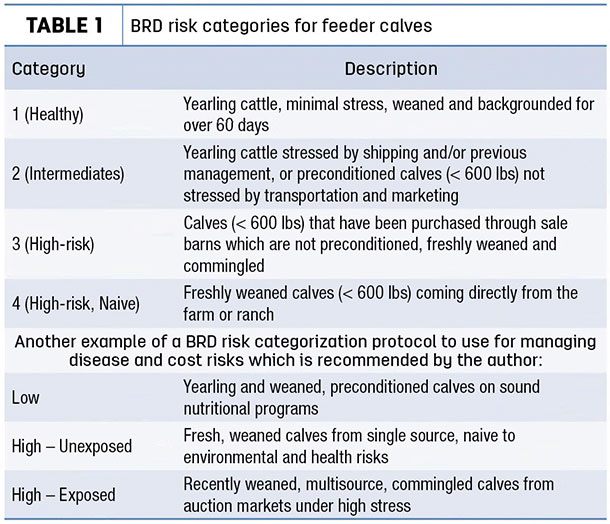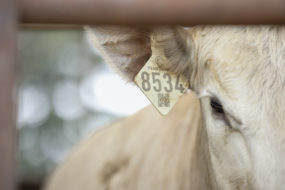Based on the information available relative to the history of a group of cattle, it is appropriate to classify the group within a certain health risk level and manage them accordingly. Genetics, age, source, vaccination program, length of transportation and weather conditions are just some of the factors taken into consideration when designating cattle as low or high risk.
Health risk classification
Calves that undergo a preconditioning period and yearling cattle from a single source with a known health record are often considered low-risk. High-risk cattle are generally calves that have been recently weaned with no history of vaccinations, transported for an extended period of time, commingled with other lots at the sale barn, or simply lack information about their past.
While it is likely for a group of cattle to exhibit characteristics of both low- and high-risk categories, South Dakota State University Extension has developed health risk classifications (see Table 1) that expand on the various combinations of risk factors.

This tool includes the potential risk for bovine respiratory disease (BRD) in a group of incoming feeder cattle and how to implement the appropriate management strategies.
Management prior to
feedlot arrival
A study performed by researchers at Oklahoma State University evaluated the effects of weaning strategies and commingling of calves from various sources on health and performance during a 42-day receiving period.
Calves bought through auction markets and then commingled were more likely to be treated for BRD than calves from a single-source ranch. In regard to weaning strategy, calves shipped at weaning were more likely to require treatment than calves preconditioned on the ranch for 45 days prior to shipping.
Consequently, the increase in morbidity led to elevated health expenses. Single-sourced calves that undergo a preconditioning period prior to entering the feedlot phase are generally at lower risk for sickness and health-related expenses than calves shipped immediately at weaning time and commingled.
Management at the feedyard
With focus on health risk level, receiving protocols should consider the total time spent in the marketing and transportation process for a given group of cattle and implement the appropriate vaccination program. Stress associated with weaning and transportation can suppress the immune system of calves, so allowing calves to rest prior to processing can result in a more favorable vaccine response.
Success of a vaccination program is dependent on the effectiveness of the vaccines, proper handling, timing and route of administration, as well as nutritional status of the calf.
According to a survey completed by feedlot veterinarians representing nearly 11.3 million cattle on feed in the U.S. and Canada, cattle health risk was ranked as the top predictive factor for feeder cattle morbidity and mortality. When possible, veterinarians recommend high-risk cattle to be housed in smaller pens of approximately 100 head with 13 inches of bunk space per head.
From a labor standpoint, feedlot veterinary consultants suggested one pen rider per 2,700 head of high-risk cattle or 5,500 head of low-risk cattle. Additionally, veterinarians recommended an average of 7,000 head of high-risk or 16,000 head of low-risk cattle per feedlot doctor.
Nearly 96 percent of veterinary consultants surveyed recommended metaphylactic treatment at the time of arrival for high-risk populations, while 9 percent recommended metaphylaxis for low-risk populations. If intending to use feed-grade antimicrobials, visit with your local veterinarian in advance to complete the proper steps required for obtaining a Veterinary Feed Directive.
Conclusion
Managing differences in health risk of incoming cattle presents challenges. Recognition in advance provides opportunity to refine receiving protocols accordingly to enhance adaptability of incoming feeder cattle. Starting cattle off on the right foot in terms of health and nutrition is important for long-term performance throughout the finishing phase.
Good recordkeeping and effective communication between feedlot personnel, veterinary consultants and nutritionists is important to successfully implement any receiving protocol. ![]()
PHOTO: Consultants suggest one pen rider per 2,700 head of high-risk cattle or 5,500 head of low-risk cattle. Staff photo.
Erin Laborie is a Nebraska Extension educator and member of the University of Nebraska Beef Team in Beaver City, Nebraska.
References omitted but are available upon request. Click here to email an editor.

-
Erin Laborie
- Extension Educator – Beef Systems
- Nebraska Extension
- Email Erin Laborie







